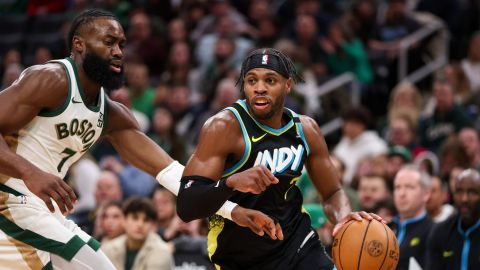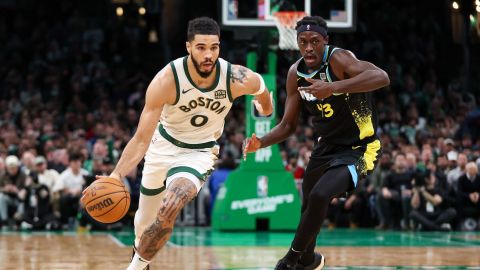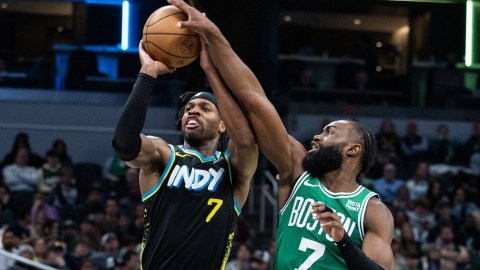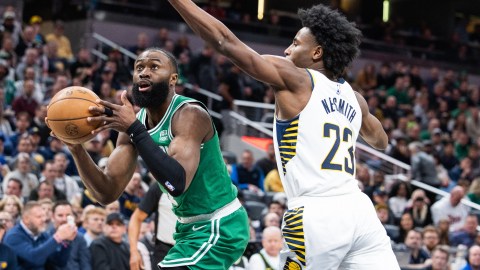 “We’ll have to evaluate and see what we’ll do the next time. I would say we’ll probably have him in next time.”
“We’ll have to evaluate and see what we’ll do the next time. I would say we’ll probably have him in next time.”
Frank Vogel said a lot of things in response to reporters’ questions on Wednesday night, but all his explaining and rationalizing did little to answer the only question that mattered: Why?
Why was Roy Hibbert, the Pacers’ 7-foot-2 defensive backbone and emotional leader, on the bench for two pivotal defensive possessions in overtime of the first game of the Eastern Conference finals? What possessed Vogel, one of the brightest young coaches in the NBA, to sit his team’s rim protector and open the lane for LeBron James to drive freely to the hoop not once, but twice?
Why?
“We expected it to be LeBron. We expected [Chris] Bosh to be a spacing option. If Roy were in the game, [Bosh] probably would have been the first or second option. If it didn’t come to LeBron … LeBron could one-bounce, draw Roy to the rim and have Bosh spot it up.”
Vogel seemed to believe that Heat coach Erik Spoelstra would have been able to exploit Hibbert’s presence with one of Miami’s many small lineups on the decisive play. In case you have not been caught up on what the situation was, the Heat trailed by one point as a result of three free throws by Paul George and were inbounding the ball with 2.2 seconds left.
The final play was anticlimactic, with James breezing by George, who had rushed out to protect against a jump shot. With Hibbert on the bench, Indiana had no one to contest James’ game-winning layup as time expired. In an instant, the Pacers’ best chance at stealing a game in this series may have escaped them.
But the drive-and-kick — or one-dribble-and-kick — scenario Vogel worried about was never really a threat. We know this not because of any wise coaching acumen, but because we’ve been around long enough to know how the space-time continuum works.
Let’s say the ball gets inbounded to James, defended by George. Assuming every Pacer more or less did his job — a safe assumption for the league’s top defensive team — stopping Bosh or any other Heat player from easily getting free for a catch-and-shoot would be relatively easy to defend simply by switching screens. If the Pacers closed off that option, James would have a little more than a second to drive or shoot. Then Hibbert could safely crash into the paint, knowing James has no time to send the ball back out to an open Bosh (or anyone else) for a jump shot.
“It’s the dilemma they present. Obviously, with the way it worked out, you know it would have been better to have Roy in the game. But you don’t know. If that happens, maybe Bosh is making the jump shot, and we’re all talking about that.”
With all due respect, Frank, sorry, but no. Unless James has figured out how to freeze time, which we shouldn’t put past him, he would be forced to generate a shot for himself against George and Hibbert, two of the Pacers’ best defensive players. That is the only option time would permit. Vogel obviously thought this thing through. His rationale concerning Bosh certainly would have made total sense if there had been more time on the clock. Had he thought it through a little further, though, maybe he would have realized what the Heat can and cannot do in 2.2 seconds and rethought his strategy.
(To make matters worse, Tyler Hansbrough replaced Hibbert and covered Bosh. Not only is Hansbrough a worse defender than Hibbert, he is a foul magnet. So even if Bosh wasn’t left open, there is a good chance he would have been going to the line for two game-winning free throws even if the play developed as Vogel imagined. Oh, and the Pacers switched anyway, which left Sam Young on Bosh about 10 feet from the hoop. How that is a better matchup, we’ll never know.)
All that thinking really was not necessary, however. Vogel is smart. But in some instances, smart coaches can be too smart. Hibbert, George and David West are the top three reasons the Pacers are here, in the conference finals, and on the game’s most crucial possessions, they need to be on the court. It does not take a spreadsheet and a scouting video to know that a coach has to trust his main players when the game is on the line.
Maybe, if Hibbert had been in the game, Spoelstra would have drawn up something quick-hitting and virtually unstoppable. Maybe it would have been something the Pacers had never seen before. But in that case, wouldn’t Vogel want one of his smartest players and his most imposing shot-blocker on the court to help his scrappy squad react appropriately? Don’t Hibbert’s instincts trump his lack of agility in that situation?
“We’ll have to evaluate and see what we’ll do the next time. I would say we’ll probably have him in next time.”
Vogel can evaluate, ponder and agonize all he wants, but this is really not very complicated. Somehow, he talked himself into thinking having Hibbert in or out of the game was a tough decision, when it really should have been one of the easiest calls he had to make all night.
Have a question for Ben Watanabe? Send it to him via Twitter at @BenjeeBallgame or send it here.



